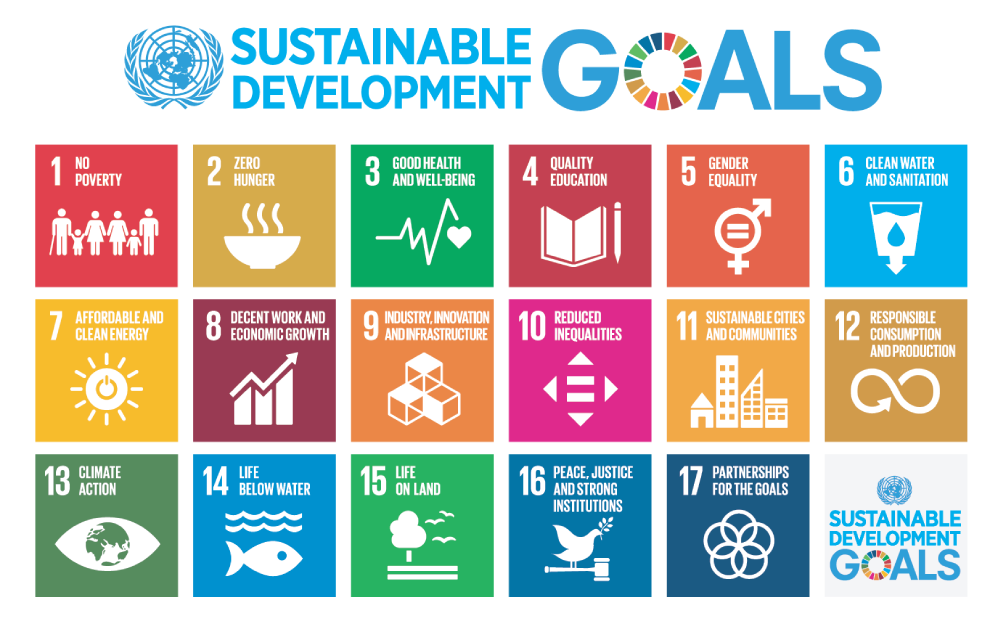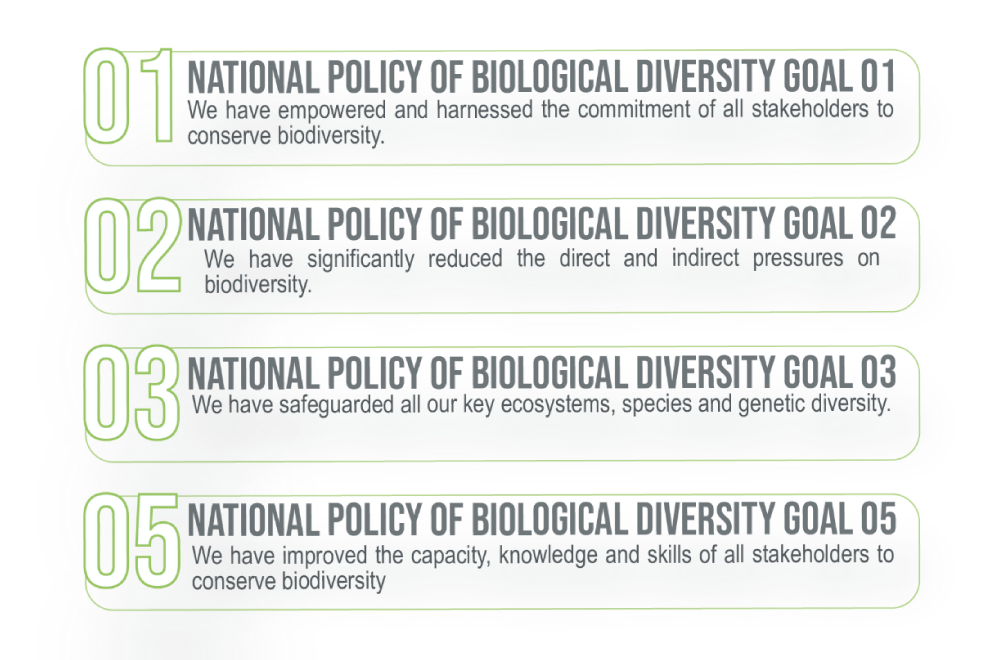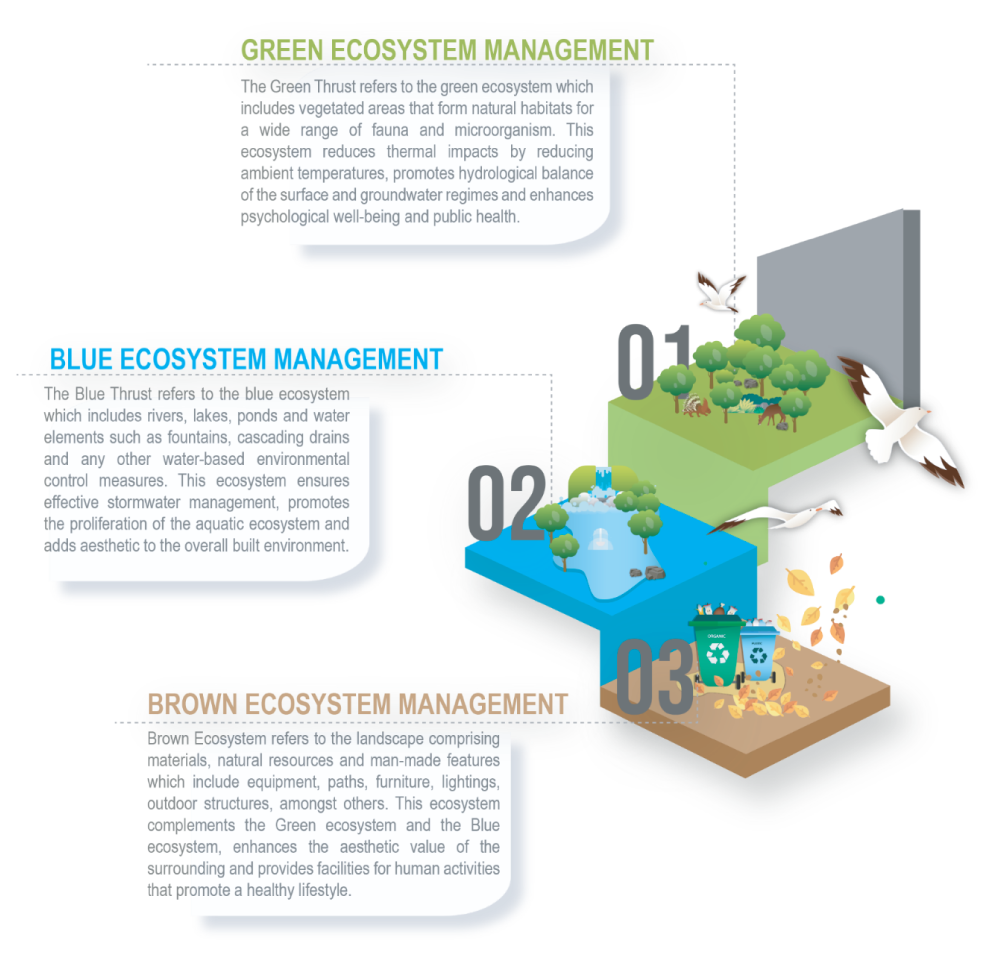

Creating sustainable places with the wellbeing of the community in mind, for people to call home, want to be a part of, grow up and grow old in.
The consolidation of these efforts; bringing together the design process, biodiversity enrichment, land
conservation, township management and education is to meet the needs of the future in a holistic,
forward-looking and complete manner. This parallels our brand value of respecting nature and the environment.
In achieving the Vision and Mission Statements, this Policy serves to conserve and integrate biodiversity into Gamuda Land’s development projects and is focused on six key objectives:
| “Biodiversity”: | Also known as biological diversity. The variability among living organisms from all sources including, inter alia, terrestrial, marine and other aquatic ecosystems and the ecological complexes of which they are part; this includes diversity within species, between species and of ecosystems. |
| “Built Environment”: | Human-made space in which people live, work, and recreate on a day-today basis. |
| “Community well-being”: | Community well-being is the combination of healthy social, economic, environmental and cultural conditions that are essential for a community to nurture and fulfil their potential. |
| “Conservation”: | The management of human use of the biosphere so that it may yield the greatest sustainable benefit to current generations while maintaining its potential to meet the needs and aspirations of future generations: Thus conservation is positive, embracing preservation, maintenance, sustainable utilisation, restoration, and enhancement of the natural environment. |
| “Ecosystem”: | A dynamic complex of plant, animal, fungal, and micro-organism communities and their associated non-living environment interacting as an ecological unit. |
| “Endemic”: | Native species (flora or fauna) and restricted to a specified area |
| “Property Development”: | Townships and high-rise development projects |
| “Gamuda Land”: | The property development arm of Gamuda Berhad |
| “Native species”: | Also known as indigenous species. Plants, animals, fungi and microorganisms that occur naturally in a specified area. |
| “Invasive Species”: | A species that is not native to a specific location (an introduced species), and that has a tendency to spread to a degree believed to cause damage to the environment, human economy or human health. |
| “Urban Green Spaces”: | Urban green spaces refer to public and private open spaces in urban areas, primarily covered by vegetation, which are directly (e.g. active or passive recreation) or indirectly (e.g. positive influence on the urban environment) available for the users. Also includes small water bodies such as ponds, lakes and streams. |



Four of of five National Policy on Biological Diversity relatable to Gamuda Parks Policy
 This goal seeks to encourage and empower all stakeholders to conserve our biodiversity. These stakeholders ranging from Federal and State governments, civil society, local communities and private sectors, who need to work hand in hand to conserve biodiversity. Gamuda Parks as a team under Gamuda Land is committed to implementing efforts to improve biodiversity values within Gamuda Land development projects and building biodiversity awareness of its stakeholders.
This goal seeks to encourage and empower all stakeholders to conserve our biodiversity. These stakeholders ranging from Federal and State governments, civil society, local communities and private sectors, who need to work hand in hand to conserve biodiversity. Gamuda Parks as a team under Gamuda Land is committed to implementing efforts to improve biodiversity values within Gamuda Land development projects and building biodiversity awareness of its stakeholders. This goal seeks to encourage and empower all stakeholders to conserve our biodiversity. These stakeholders ranging from Federal and State governments, civil society, local communities and private sectors, who need to work hand in hand to conserve biodiversity. Gamuda Parks as a team under Gamuda Land is committed to implementing efforts to improve biodiversity values within Gamuda Land development projects and building biodiversity awareness of its stakeholders.
This goal seeks to encourage and empower all stakeholders to conserve our biodiversity. These stakeholders ranging from Federal and State governments, civil society, local communities and private sectors, who need to work hand in hand to conserve biodiversity. Gamuda Parks as a team under Gamuda Land is committed to implementing efforts to improve biodiversity values within Gamuda Land development projects and building biodiversity awareness of its stakeholders. This goal aims to ensure the resilience of our key ecosystems, species and genetic diversity and that they are managed in an effective and integrated manner. The goal will ultimately conserve areas of natural habitat and protect both flora and fauna species from extinction. Gamuda Parks is committed to enhance aquatic biodiversity, and conserve native and threatened species within Gamuda Land development projects.
This goal aims to ensure the resilience of our key ecosystems, species and genetic diversity and that they are managed in an effective and integrated manner. The goal will ultimately conserve areas of natural habitat and protect both flora and fauna species from extinction. Gamuda Parks is committed to enhance aquatic biodiversity, and conserve native and threatened species within Gamuda Land development projects. This goal ensures that all stakeholders have adequate capabilities, knowledge, access to information, tools, and networks to effectively plan, manage and monitor biodiversity conservation. In order to gain capacity, knowledge and skills on biodiversity conservation, government, private sectors and academia are expected to conduct relevant research, whereas local communities and civil society have access to appropriate support system including funding support. Gamuda Parks strives towards building awareness of its stakeholders, as part of its efforts to develop knowledge on biodiversity conservation.
This goal ensures that all stakeholders have adequate capabilities, knowledge, access to information, tools, and networks to effectively plan, manage and monitor biodiversity conservation. In order to gain capacity, knowledge and skills on biodiversity conservation, government, private sectors and academia are expected to conduct relevant research, whereas local communities and civil society have access to appropriate support system including funding support. Gamuda Parks strives towards building awareness of its stakeholders, as part of its efforts to develop knowledge on biodiversity conservation.
Gamuda Parks Biodiversity Policy Comprises Of Green Thrust, Blue Thrust And Brown Thrust
Green ecosystem refers to vegetated areas that form natural habitats for a wide range of macrofauna and microfauna. This ecosystem reduces thermal impacts by reducing ambient temperatures, promotes hydrological balance of the surface and groundwater regimes and enhances psychological well-being and public health.
The objectives of the Green Ecosystem policy thrust includes the:Blue ecosystem refers to water bodies which include rivers, lakes, ponds and water elements such as fountains, cascading drains and any other water-based environmental control measures. This ecosystem ensures effective stormwater management, promotes the proliferation of the aquatic ecosystem and adds aesthetic to the overall built environment.
The objectives of the Blue Ecosystem policy thrust includes the:Brown ecosystem refers to the hardscape comprising materials, natural resources and man-made features which include soil, equipments, paths, furniture, lightings, outdoor structures, among others. This ecosystem complements the Green Ecosystem and the Blue Ecosystem, ensure responsible and sustainable material and resources, enhances the aesthethic value of the surrounding and provides facilities for human activities that promote a healthy lifestyle.
The objectives of the Brown Ecosystem policy thrust includes the:Creating sustainable places with the wellbeing of the community in mind, for people to call home, want to be a part of, grow up and grow old in.
The consolidation of these efforts; bringing together the design process, biodiversity enrichment, land conservation, township management and education is to meet the needs of the future in a holistic, forward-looking and complete manner. This parallels our brand value of respecting nature and the environment.
In achieving the Vision and Mission Statements, this Policy serves to conserve and integrate biodiversity into Gamuda Land’s development projects and is focused on six key objectives:
| “Biodiversity”: | Also known as biological diversity. The variability among living organisms from all sources including, inter alia, terrestrial, marine and other aquatic ecosystems and the ecological complexes of which they are part; this includes diversity within species, between species and of ecosystems. |
| “Built Environment”: | Human-made space in which people live, work, and recreate on a day-today basis. |
| “Community well-being”: | Community well-being is the combination of healthy social, economic, environmental and cultural conditions that are essential for a community to nurture and fulfil their potential. |
| “Conservation”: | The management of human use of the biosphere so that it may yield the greatest sustainable benefit to current generations while maintaining its potential to meet the needs and aspirations of future generations: Thus conservation is positive, embracing preservation, maintenance, sustainable utilisation, restoration, and enhancement of the natural environment. |
| “Ecosystem”: | A dynamic complex of plant, animal, fungal, and micro-organism communities and their associated non-living environment interacting as an ecological unit. |
| “Endemic”: | Native species (flora or fauna) and restricted to a specified area |
| “Property Development”: | Townships and high-rise development projects |
| “Gamuda Land”: | The property development arm of Gamuda Berhad |
| “Native species”: | Also known as indigenous species. Plants, animals, fungi and microorganisms that occur naturally in a specified area. |
| “Invasive Species”: | A species that is not native to a specific location (an introduced species), and that has a tendency to spread to a degree believed to cause damage to the environment, human economy or human health. |
| “Urban Green Spaces”: | Urban green spaces refer to public and private open spaces in urban areas, primarily covered by vegetation, which are directly (e.g. active or passive recreation) or indirectly (e.g. positive influence on the urban environment) available for the users. Also includes small water bodies such as ponds, lakes and streams. |


This National Policy for Biological Diversity has been established in line with the relevant elements of the National Policy on Biological Diversity 2016-2025 (NPBD). The NPBD was established to provide direction and framework for the nation to conserve our biodiversity and ensure use of biodiversity is managed sustainably in response of increasing urban developments throughout Malaysia.
The NPBD statement “Malaysia is committed to conserve its biological diversity, promote its sustainable use and ensure the fair and equitable sharing of benefits arising from the utilization of biological resources” is the foundation upon which five overarching goals were promulgated. Gamuda Parks Policy fulfills four out of the five goals of the Policy (Figure 4.1)
Four of of five National Policy on Biological Diversity relatable to Gamuda Parks Policy
 This goal seeks to encourage and empower all stakeholders to conserve our biodiversity. These stakeholders ranging from Federal and State governments, civil society, local communities and private sectors, who need to work hand in hand to conserve biodiversity. Gamuda Parks as a team under Gamuda Land is committed to implementing efforts to improve biodiversity values
This goal seeks to encourage and empower all stakeholders to conserve our biodiversity. These stakeholders ranging from Federal and State governments, civil society, local communities and private sectors, who need to work hand in hand to conserve biodiversity. Gamuda Parks as a team under Gamuda Land is committed to implementing efforts to improve biodiversity values This goal aims to ensure that all sectors of the economy are planned and managed in a manner that does not impose pressures on our biological resources. Malaysia as a developing country encounters challenges in managing biodiversity whereas at the same time development and industrialisation are required to move towards developed country status. Therefore, all sectors are responsible to manage extraction of raw materials and water resource, prevent pollution in water bodies, on land and air. Gamuda Parks strives towards monitoring and addressing environmental impacts from Gamuda Land development projects, improving water quality and enhancing water resource management.
This goal aims to ensure that all sectors of the economy are planned and managed in a manner that does not impose pressures on our biological resources. Malaysia as a developing country encounters challenges in managing biodiversity whereas at the same time development and industrialisation are required to move towards developed country status. Therefore, all sectors are responsible to manage extraction of raw materials and water resource, prevent pollution in water bodies, on land and air. Gamuda Parks strives towards monitoring and addressing environmental impacts from Gamuda Land development projects, improving water quality and enhancing water resource management. This goal aims to ensure the resilience of our key ecosystems, species and genetic diversity and that they are managed in an effective and integrated manner. The goal will ultimately conserve areas of natural habitat and protect both flora and fauna species from extinction. Gamuda Parks is committed to enhance aquatic biodiversity, and conserve native and threatened species within Gamuda Land development projects.
This goal aims to ensure the resilience of our key ecosystems, species and genetic diversity and that they are managed in an effective and integrated manner. The goal will ultimately conserve areas of natural habitat and protect both flora and fauna species from extinction. Gamuda Parks is committed to enhance aquatic biodiversity, and conserve native and threatened species within Gamuda Land development projects. This goal ensures that all stakeholders have adequate capabilities, knowledge, access to information, tools, and networks to effectively plan, manage and monitor biodiversity conservation. In order to gain capacity, knowledge and skills on biodiversity conservation, government, private sectors and academia are expected to conduct relevant research, whereas local communities and civil society have access to appropriate support system including funding support. Gamuda Parks strives towards building awareness of its stakeholders, as part of its efforts to develop knowledge on biodiversity conservation.
This goal ensures that all stakeholders have adequate capabilities, knowledge, access to information, tools, and networks to effectively plan, manage and monitor biodiversity conservation. In order to gain capacity, knowledge and skills on biodiversity conservation, government, private sectors and academia are expected to conduct relevant research, whereas local communities and civil society have access to appropriate support system including funding support. Gamuda Parks strives towards building awareness of its stakeholders, as part of its efforts to develop knowledge on biodiversity conservation.
Gamuda Parks Biodiversity Policy Comprises Of Green Thrust, Blue Thrust And Brown Thrust
Green ecosystem refers to vegetated areas that form natural habitats for a wide range of macrofauna and microfauna. This ecosystem reduces thermal impacts by reducing ambient temperatures, promotes hydrological balance of the surface and groundwater regimes and enhances psychological well-being and public health.
The objectives of the Green Ecosystem policy thrust includes the:
Blue ecosystem refers to water bodies which include rivers, lakes, ponds and water elements such as fountains, cascading drains and any other water-based environmental control measures. This ecosystem ensures effective stormwater management, promotes the proliferation of the aquatic ecosystem and adds aesthetic to the overall built environment.
The objectives of the Blue Ecosystem policy thrust includes the:
Brown ecosystem refers to the hardscape comprising materials, natural resources and man-made features which include soil, equipments, paths, furniture, lightings, outdoor structures, among others. This ecosystem complements the Green Ecosystem and the Blue Ecosystem, ensure responsible and sustainable material and resources, enhances the aesthetic value of the surrounding and provides facilities for human activities that promote a healthy lifestyle.
The objectives of the Brown Ecosystem policy thrust includes the: